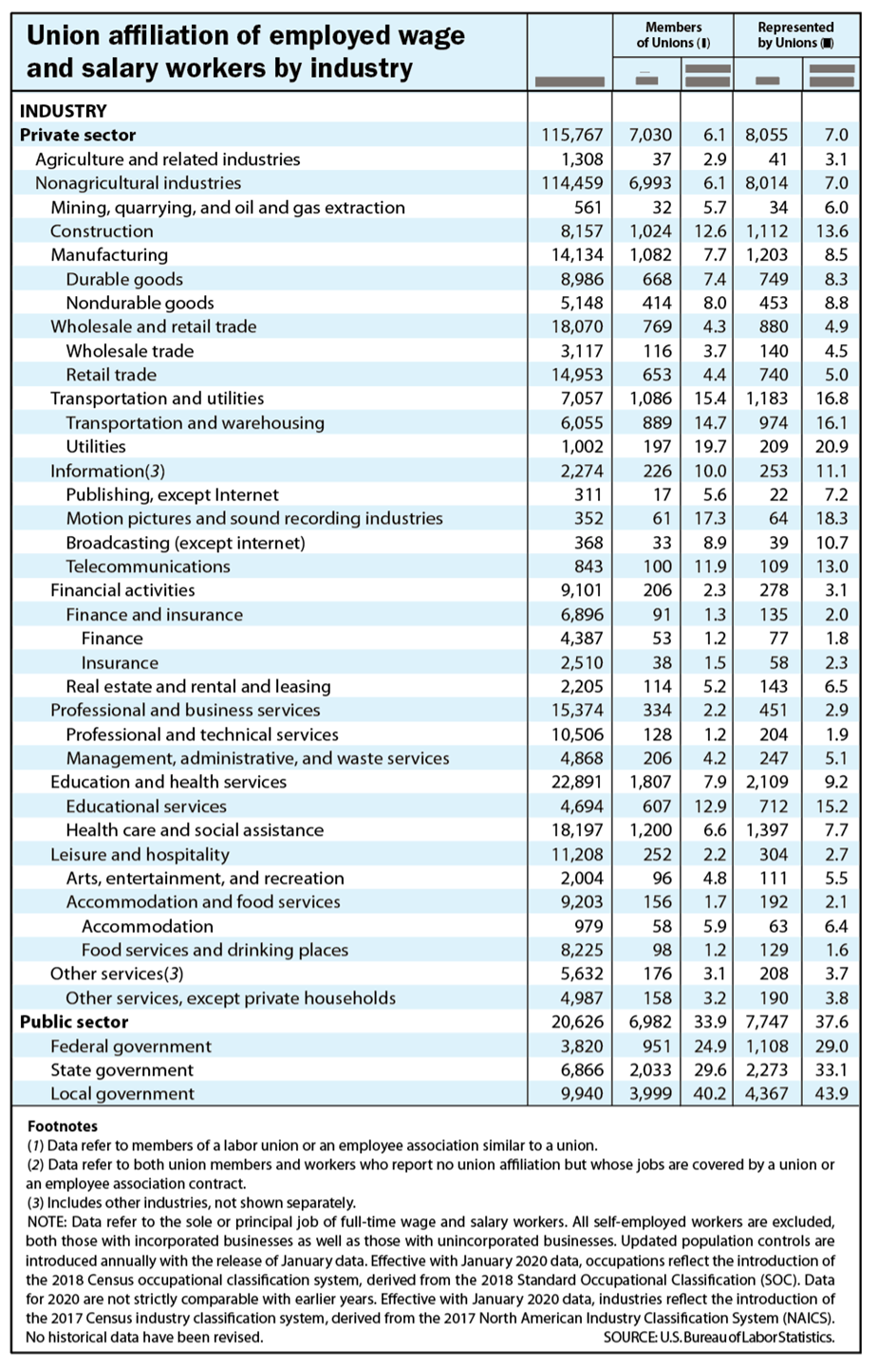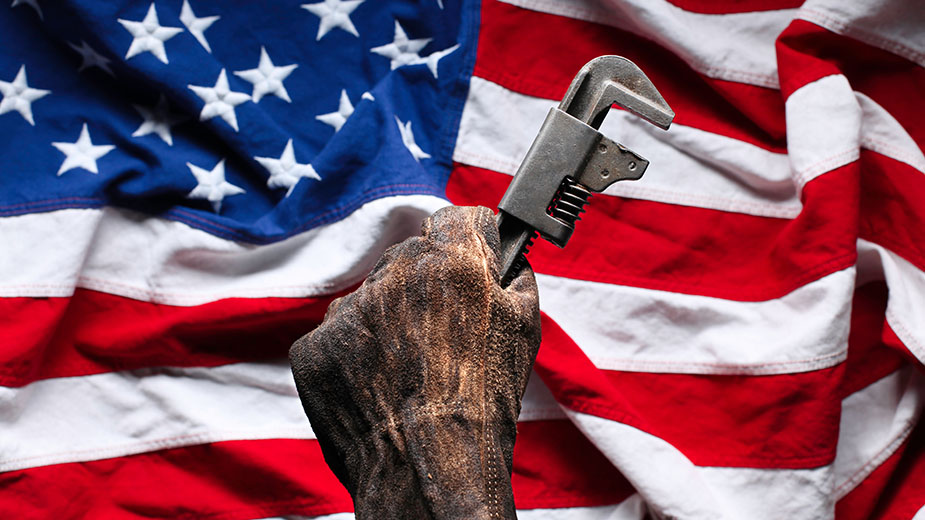YOUNGSTOWN, Ohio – In 2021, the number of wage and salary workers belonging to unions continued to decline (minus 241,000) to 14 million and the percentage who were members of unions – the union membership rate – was 10.3%, the U.S. Bureau of Labor Statistics reported in January.
That rate, 10.3%, is down from 10.8% in 2020, when the rate increased because of a disproportionately large decline in the total number of nonunion workers compared with the decline in the number of union members.
The 2021 unionization rate is the same as the 2019 rate of 10.3%. In 1983, the first year for which comparable union data are available, the union membership rate was 20.1% and there were 17.7 million union workers.
Ohio, Pa. Membership
In 2021, union members accounted for 12.0% of wage and salary workers in Ohio, compared with 13.2% in 2020. Union membership rate for Ohio was at its peak in 1989, when it averaged 21.3%, and at its low point in 2019 at 11.9%.
In Pennsylvania, union members accounted for 12.9% of wage and salary workers in 2021, compared with 13.5% in 2020. Union membership peaked in 1989, when it averaged 20.9%; low points occurred in 2017 and 2019 at 12.0%.
Ten states had union membership rates below 5%. South Carolina had the lowest rate (1.7%), followed by North Carolina (2.6%) and Utah (3.5%). Two states had union membership rates over 20% in 2021: Hawaii (22.4%) and New York (22.2%).
NATIONAL survey highlights
The union membership rate in 2021 of public-sector workers (33.9%) continued to be more than five times higher than the rate of private-sector workers (6.1%).
The highest unionization rates were among workers in education, training, and library occupations (34.6%) and protective service occupations (33.3%).
Men continued to have a higher union membership rate (10.6%) than women (9.9%).
The gap between union membership rates for men and women has narrowed considerably since 1983 (the earliest year for which comparable data are available), when rates for men and women were 24.7% and 14.6%, respectively.
Black workers remained more likely to be union members than White, Asian or Hispanic workers.
Nonunion workers had median weekly earnings that were 83% of earnings for workers who were union members ($975 versus $1,169).
Industry and occupation
In 2021, seven million employees in the public sector belonged to unions, the same as in the private sector.
Union membership decreased by 191,000 over the year in the public sector. The public-sector union membership rate declined by 0.9% in 2021 to 33.9%, following an increase of 1.2% in 2020.
In 2021, the union membership rate continued to be highest in local government (40.2%), which employs many workers in heavily unionized occupations, such as police officers, firefighters and teachers.
The number of union workers employed in the private sector changed little over the year. However, the number of private-sector nonunion workers increased in 2021.
The private-sector unionization rate declined by 0.2% in 2021 to 6.1% – slightly lower than its 2019 rate of 6.2%.
Industries with high unionization rates included utilities (19.7%), motion pictures and sound recording industries (17.3%) and transportation and warehousing (14.7%).
Low unionization rates occurred in finance (1.2%), professional and technical services (1.2%), food services and drinking places (1.2%) and insurance (1.5%).
Among occupational groups, the highest unionization rates in 2021 were in education, training and library occupations (34.6%) and protective service occupations (33.3%).
Unionization rates were lowest in food preparation and serving-related occupations (3.1%), sales and related occupations (3.3%), computer and mathematics occupations (3.7%), personal care and service occupations (3.9%) and farming, fishing and forestry occupations (4%).
Selected characteristics
The number of men who were union members, at 7.5 million, changed little in 2021, while the number of women who were union members declined by 182,000 to 6.5 million. The unionization rate for men decreased by 0.4% over the year to 10.6%.
The women’s union membership rate declined by 0.6% to 9.9%. The 2021 decreases in union membership rates for men and women reflect increases in the total number of nonunion workers.
The rate for men is below the 2019 rate (10.8%), while the rate for women is above the 2019 rate (9.7%).
Among major race and ethnicity groups, Black workers continued to have a higher union membership rate in 2021 (11.5%) than White workers (10.3%), Asian workers (7.7%) and Hispanic workers (9%).
The union membership rate declined by 0.4% for White workers, by 0.8% for Black workers, by 1.2% for Asian workers and by 0.8% for Hispanic workers.
The 2021 rates for Whites, Blacks and Hispanics are little or no different from 2019, while the rate for Asians is lower.
By age, workers ages 45 to 54 had the highest union membership rate in 2021, at 13.1%. Younger workers – those ages 16 to 24 – had the lowest rate, at 4.2%.
Earnings
Among full-time wage and salary workers, union members had median weekly earnings of $1,169 in 2021, while those who were not union members had median weekly earnings of $975.
In addition to coverage by a collective bargaining agreement, these earnings differences reflect a variety of influences, including variations in the distributions of union members and nonunion employees by occupation, industry, age, firm size or geographic region.

